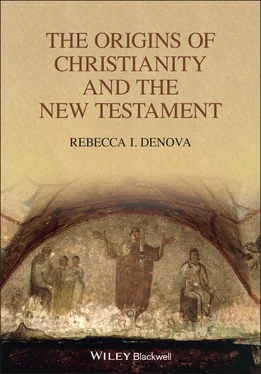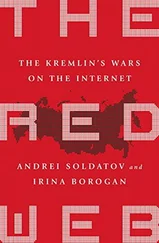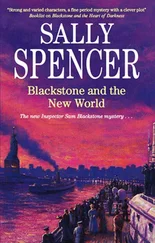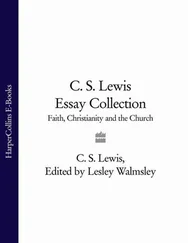10 Index
11 End User License Agreement
1 Cover
2 Series page Blackwell Ancient Religions Ancient religious practice and belief are at once fascinating and alien for twenty–first–century readers. There was no Bible, no creed, no fixed set of beliefs. Rather, ancient religion was characterized by extraordinary diversity in belief and ritual. This distance means that modern readers need a guide to ancient religious experience. Written by experts, the books in this series provide accessible introductions to this central aspect of the ancient world. Published Ancient Greek Divination Sarah Iles Johnston Magic in the Ancient Greek World Derek Collins Religion in the Roman Empire James B. Rives Ancient Greek Religion, Second Edition Jon D. Mikalson Ancient Egyptian Tombs: The Culture of Life and Death Steven Snape Exploring Religion in Ancient Egypt Stephen Quirke Greek and Roman Religions Rebecca I. Denova
3 Title page THE ORIGINS OF CHRISTIANITY AND THE NEW TESTAMENT Rebecca I. Denova University of Pittsburgh Pittsburgh, Pennsylvania
4 Copyright
5 Table of Contents
6 Acknowledgments
7 Preface
8 Begin Reading
9 Glossary
10 Index
11 End User License Agreement
1 i
2 ii
3 iii
4 iv
5 v
6 vi
7 vii
8 viii
9 ix
10 x
11 xi
12 xii
13 xiii
14 xiv
15 1
16 2
17 3
18 4
19 5
20 6
21 7
22 8
23 9
24 10
25 11
26 12
27 13
28 14
29 15
30 16
31 17
32 18
33 19
34 20
35 21
36 22
37 23
38 24
39 25
40 26
41 27
42 28
43 29
44 30
45 31
46 32
47 33
48 34
49 35
50 36
51 37
52 38
53 39
54 40
55 41
56 42
57 43
58 44
59 45
60 46
61 47
62 48
63 49
64 50
65 51
66 52
67 53
68 54
69 55
70 56
71 57
72 58
73 59
74 60
75 61
76 62
77 63
78 64
79 65
80 66
81 67
82 68
83 69
84 70
85 71
86 72
87 73
88 74
89 75
90 76
91 77
92 78
93 79
94 80
95 81
96 82
97 83
98 84
99 85
100 86
101 87
102 88
103 89
104 90
105 91
106 92
107 93
108 94
109 95
110 96
111 97
112 98
113 99
114 100
115 101
116 102
117 103
118 104
119 105
120 106
121 107
122 108
123 109
124 110
125 111
126 112
127 113
128 114
129 115
130 116
131 117
132 118
133 119
134 120
135 121
136 122
137 123
138 124
139 125
140 126
141 127
142 128
143 129
144 130
145 131
146 132
147 133
148 134
149 135
150 136
151 137
152 138
153 139
154 140
155 141
156 142
157 143
158 144
159 145
160 146
161 147
162 148
163 149
164 150
165 151
166 152
167 153
168 154
169 155
170 156
171 157
172 158
173 159
174 160
175 161
176 162
177 163
178 164
179 165
180 166
181 167
182 168
183 169
184 170
185 171
186 172
187 173
188 174
189 175
190 176
191 177
192 178
193 179
194 180
195 181
196 182
197 183
198 184
199 185
200 186
201 187
202 188
203 189
204 190
205 191
206 192
207 193
208 194
209 195
210 196
211 197
212 198
213 199
214 200
215 201
216 202
217 203
218 204
219 205
220 206
221 207
222 208
223 209
224 210
225 211
226 212
227 213
228 214
229 215
230 216
231 217
232 218
233 219
234 220
235 221
236 222
237 223
238 224
239 225
240 226
241 227
242 228
243 229
244 230
245 231
246 232
247 233
248 234
249 235
250 236
251 237
252 238
253 239
254 240
255 241
256 242
257 243
258 244
259 245
260 246
261 247
262 248
263 249
264 250
265 251
266 252
267 253
268 254
269 255
270 256
271 257
272 258
273 259
274 260
275 261
276 262
277 263
278 264
279 265
280 266
281 267
282 268
Thanks so much for their help and patience to my husband Jim, my daughter Rachael (and PJ), and my grandchildren, Madison, John, and Wyatt. And a special thanks to Benjamin Davis Gordon, PhD, colleague and source, for helping me understand Second Temple Judaism.
The phrase “the Quest for the Historical Jesus” has become popular through hundreds of new books. If you subscribe to cable you will find documentaries on History, Discovery, Smithsonian, and National Geographic Channels. New archaeological discoveries often make headlines (especially those in the Galilee), and “deconstructionist histories” are often designed to shock.
For many lay Christians, a new fascination with the study of Jesus is confusing. We have the gospels, the letters of Paul, and the rest of the New Testament that told the story. And these stories are re-enacted in the liturgy at Christmas and Easter. Priests and ministers are trained in Seminaries to elucidate the “meaning” of the texts, updating them for modern Christians. Why does any of this need “revision?” And what is meant by “the historical Jesus ?” Is he different from the Jesus of the New Testament?
The simple answer is “yes,” if we mean that the Jesus who was an apocalyptic prophet in the first century is different from the “Christ” of the churches (divine) and eventually the second member of “The Trinity,” co-equal with God (325 ce). Centuries of later Christian Theology and traditions are constantly read back into the gospels, where they are historically out of place. For example, Jesus was not the founder of Christianity; all our evidence demonstrates that he and his early followers were not interested in starting a new religion. Jesus was not “the first Christian.”
This surprises most people. In the first century, there was no such thing as “Christianity” as a separate religious system. It was only formulated in the second century when Christian leaders known as the Church Fathers argued for a different system from Judaism. The term “Christian” (a follower of Christ) only appears a few times in Luke’s Acts of the Apostles, written toward the end of the first century. It is not his preferred term. He most often refers to believers as “followers of the way,” or “brothers” (as does Paul in his letters). Scholars of the New Testament refer to these people as “Christians” to distinguish them from other Jewish groups at the time (and it is simply convenient).
The other surprising aspect of the gospels is that they all present four different portraits of Jesus and what he was doing. We combine Matthew and Luke together under the Christmas tree although the two nativity stories are vastly different. The great Hollywood productions of the 1950s and 1960s of “Jesus” movies did the same by picking and choosing various parts of the gospels and presenting one huge epic. Most Hollywood productions preferred Luke’s Jesus, but often added John’s speeches.
Читать дальше












